Designing Beautiful Small Bathrooms with Style
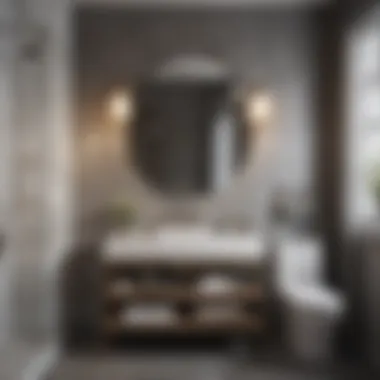
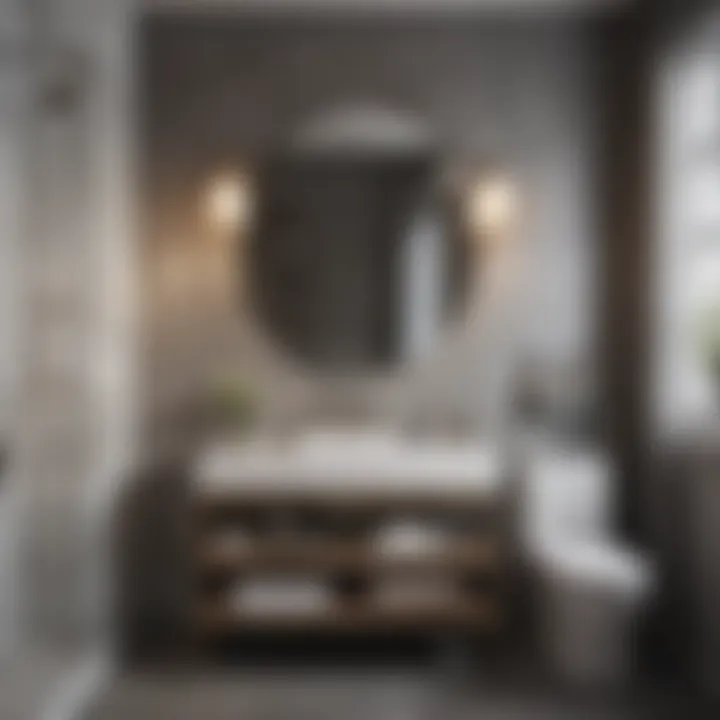
Intro
Small bathrooms often present unique challenges, but they also offer tremendous opportunities for creativity and efficient design. When done correctly, a compact space can become a stylish and functional retreat. Understanding current trends and innovative design strategies is essential for homeowners looking to optimize limited square footage without major renovations. This article will guide you through effective solutions and insights to transform your small bathroom into an aesthetic haven.
Current Trends
Color Palettes
Selecting the right color palette is crucial in small bathroom design. Light shades, such as soft whites, pale blues, and gentle greens, can create a sense of openness. These colors reflect light, making the space feel larger than it actually is. On the other hand, darker shades, when used sparingly, can provide a dramatic touch. For instance, incorporating deep navy or rich charcoal as an accent wall can add depth without overwhelming the room.
Choosing a monochromatic scheme can also unify the space. This approach combines various tones of a single color, creating a cohesive look.
Popular Styles
Current styles vary widely, yet certain themes dominate the small bathroom design landscape. Minimalism focuses on clean lines and uncluttered spaces, often utilizing a mix of white and wood elements. For those who enjoy more character, the bohemian style offers a relaxed vibe with vibrant patterns and mixed textures. Finally, the modern farmhouse style combines rustic charm with contemporary touches. This often includes wooden accents and classic hardware, creating a warm atmosphere.
Visual Ideas
Visual representation plays a significant role in comprehending design possibilities. Below are a few ideas that showcase effective strategies for small bathrooms.
Gallery of Styled Bathrooms and Bedrooms
- Compact yet Functional: A bathroom featuring a floating vanity and wall-mounted shelves maximizes storage without consuming floor space.
- Neutral Palette with Accents: A small bathroom with warm beige walls and navy blue accessories offers elegance and style.
- Nature-Inspired: Incorporating greenery creates a serene environment. Plants like ferns work well in low-light conditions, adding freshness.
Before-and-After Transformations
Transformations highlight the impact of thoughtful design.
Consider small adjustments, such as swapping out bulky vanities for slimmer alternatives, which often yield remarkable results.
- A dated bathroom with heavy cabinetry can turn into a modern oasis simply by replacing those pieces with stylish open shelving.
- Updating fixtures and adding stylish mirrors can completely alter the ambiance, making a cramped space feel welcoming.
Understanding the Challenges of Small Bathrooms
Designing small bathrooms presents unique challenges that warrant careful consideration. The limited space can greatly influence design choices, often creating constraints that require innovative solutions. A basic understanding of these challenges is essential for creating a functional and aesthetically pleasing environment. Small bathrooms can easily become overcrowded and disorganized if not approached with a clear strategy.
In this section, we will discuss two main challenges: space limitations and common design pitfalls. Knowing these challenges helps homeowners and designers to effectively navigate the complexities of small bathroom designs.
Space Limitations
One of the most significant constraints in a small bathroom is the available space. Often, these areas are only a few square meters, making it essential to plan every element efficiently. Space limitations can restrict the types of fixtures and arrangements that can be included. For example, a standard bathtub might not fit, making the selection of a compact shower crucial.
Moreover, insufficient storage is a common concern. Without adequate shelves or cabinets, small bathrooms can quickly turn chaotic. This places a premium on multifunctional pieces that both serve a purpose and occupy minimal floor space. Designers must be inventive, finding ways to optimize what little space is available. Each inch counts, so measuring and planning is vital.
Benefits of Understanding Space Limitations:
- Encourages thoughtful selection of fixtures
- Promotes space-saving solutions
- Facilitates a balanced layout that considers foot traffic
Common Design Pitfalls
Navigating the design of small bathrooms can be fraught with challenges. One prevalent pitfall is the selection of oversized fixtures. Many tend to overlook the scale of their choices, resulting in a cramped look that feels suffocating. For instance, opting for a large vanity might dominate the space, leaving little room for movement or other necessary elements.
Another common oversight is inadequate lighting. Small bathrooms often lack natural light, making them feel even smaller and darker. Relying solely on a single overhead light can exacerbate this issue. Instead, incorporating layered lighting can create a more inviting atmosphere.
Here are some design pitfalls to avoid:
- Ignoring scale: Choose appropriately sized fixtures.
- Underestimating lighting needs: Utilize a mix of ambient and task lighting.
- Neglecting vertical space: Utilize wall space for storage and decor.
"Designing small spaces requires an acute awareness of the relationship between functionality and aesthetic appeal. Every decision has an impact."
Essentials of Small Bathroom Design
Designing small bathrooms requires a thoughtful consideration of various elements. This section delves deep into the essentials of small bathroom design, aiming to balance functionality with aesthetic appeal. Understanding these essentials can dramatically transform a cramped space into a more inviting and usable area.
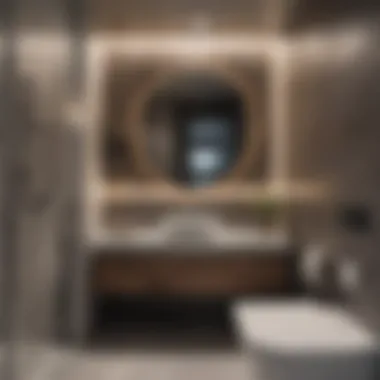
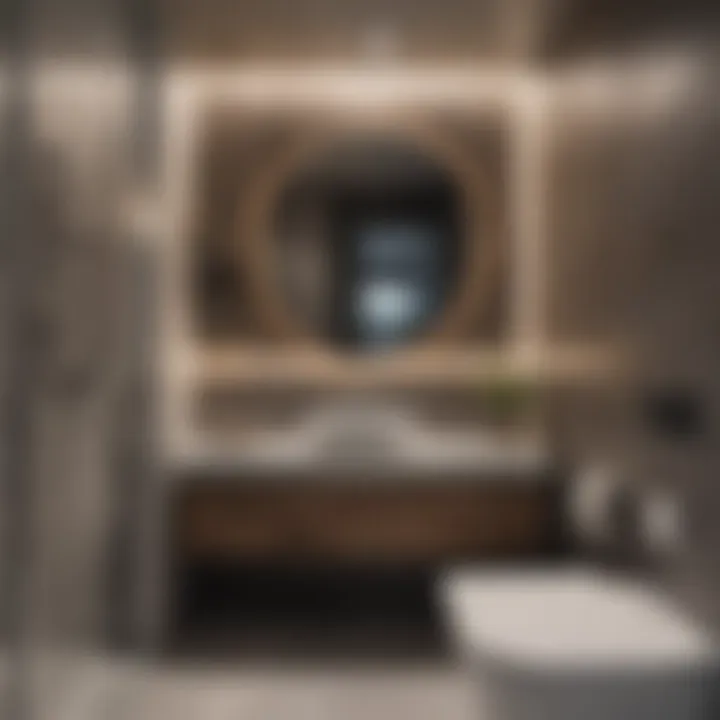
Functional Layouts
An effective layout is crucial for maximizing the usability of a small bathroom. It is about creating zones for specific activities while ensuring a clear flow of movement. A well-planned layout optimizes the available space, allowing for easier navigation and comfort. Key factors to keep in mind include:
- Zoning: Divide the space into functional areas, such as washing, grooming, and storage.
- Accessibility: Ensure that each area can be accessed easily without obstruction.
- Scale: Select fixtures and appliances that fit the scale of the bathroom. Oversized items can make the space feel cramped.
A functional layout not only enhances usability but also improves the overall aesthetic by making the space feel more organized.
Choosing the Right Fixtures
Selecting the appropriate fixtures plays a significant role in both function and style. Small bathrooms benefit from fixtures that are space-efficient yet stylish. The right choice of toilets, sinks, and showers can impact daily use and overall impression.
Toilets
Toilets in small bathrooms should prioritize compact design. A wall-mounted toilet, for instance, saves floor space and creates an illusion of a larger bathroom. These designs are also easy to clean. They are often popular for their minimalist look and space-saving qualities. The water-saving options also add a layer of eco-friendliness. One disadvantage can be the installation costs, which may be higher than traditional models.
Sinks
In a small bathroom, a pedestal sink is a common choice. It takes up less space while leaving room for a more open feel. Another innovative option is a floating sink which not only saves space but adds a modern touch. Undermount sinks can also maximize counter space, but they require careful consideration during installation. It's essential to weigh the size and style against the room’s overall scheme to ensure harmony.
Showers
Showers can dramatically change the functionality of a small bathroom. Opting for a walk-in shower instead of a tub can create an impression of space. Curbless showers provide seamless transitions and accessibility, an important aspect for all users. Glass panels can offer a contemporary look while maintaining visibility, which makes the area feel bigger. However, the open design may require more frequent cleaning.
Materials and Finishes
The choice of materials and finishes can elevate a small bathroom’s design. They can affect both the aesthetics and how spacious the area feels.
Wall Treatments
Wall treatments can be transformational in small bathrooms. Light-colored tiles or paint can reflect more light, creating an illusion of space. Using large-format tiles minimizes grout lines, giving a sleeker appearance. Additionally, moisture-resistant materials maintain durability. Dark colors, while stylish, may make the space feel constricted.
Flooring
Flooring impacts both functionality and aesthetic appeal. Materials like porcelain tile can mimic natural stone without the associated weight or cost. Choosing lighter shades or consistent patterns can enhance the feeling of openness. Avoid heavy textures, which might overpower the room. A great option is slip-resistant tiles for added safety.
Countertops
Countertops should balance durability and style. Materials like quartz or laminate offer resilience and ease of maintenance. When selecting finishes, remember that lighter colors tend to expand visual dimensions. However, heavy and dark countertops can bring richness but might make the space feel smaller.
Overall, careful selection of materials and finishes is essential for small bathroom design. It merges functionality with an aesthetic that can make any small area feel more welcoming and spacious.
Maximizing Storage in Small Bathrooms
Maximizing storage is crucial in small bathrooms because space is often a primary concern. Limited square footage can lead to clutter, making the area feel cramped and disorganized. Effective storage solutions not only enhance functionality but also improve the overall aesthetic of the space. When properly organized, a small bathroom can appear more spacious and serene.
Each storage solution must be carefully considered to fit the unique challenges of a small bathroom. Storage options need to align with the overall style while remaining practical. This section delves into various approaches to create an organized environment that meets both storage needs and design preferences.
Storage Solutions
Vanity Options
Choosing the right vanity is critical in a small bathroom. A well-designed vanity can provide essential storage while maintaining a sleek profile. Many vanities come with built-in shelves or drawers, maximizing storage capacity without occupying additional space.
One significant characteristic of vanity options is versatility. For example, floating vanities create an illusion of more floor space. This is especially beneficial for smaller rooms. However, some vanities might not offer enough storage for larger items like towels or cleaning supplies, which can be a disadvantage. Therefore, it is important to select a vanity that balances aesthetics with practicality.
Wall Shelves
Wall shelves are another excellent storage option in small bathrooms. They utilize vertical space, which is often underused. Open wall shelving allows for easy access to toiletries and decorations, adding both function and style.
One key characteristic of wall shelves is their adaptability. They can be installed at various heights and customized to fit personal needs. This flexibility can help create a unique display of decorative items or necessary bathroom supplies. However, it is essential to avoid overcrowding shelves. Too many items can create a cluttered look, diminishing the overall effect.
Over-the-Toilet Storage
Over-the-toilet storage is a clever way to optimize often wasted space. These units can house various items, from towels to toiletries, making them highly functional. An important feature of over-the-toilet options is that they can be designed to match your existing decor, enhancing the room's overall appeal.

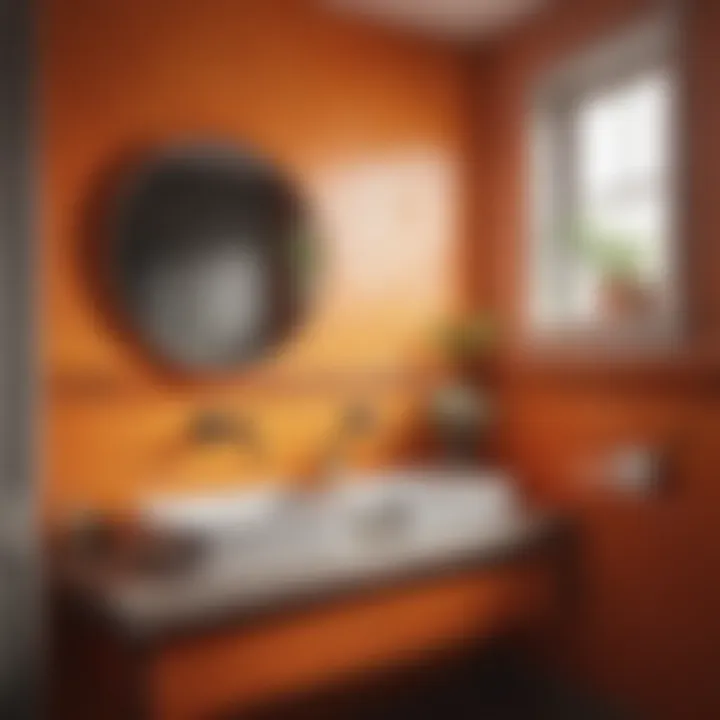
One benefit of this solution is that it keeps bathroom essentials within easy reach while keeping the floor area free. However, users need to ensure that these units are stable and securely attached, as there is a risk of them getting bumped or damaged.
Decluttering Strategies
To truly maximize the storage in small bathrooms, decluttering must be a priority. Having fewer items not only creates a more cohesive look but also allows the available storage solutions to be more effective. Regularly assessing what is necessary can help in maintaining a clean and organized space.
Lighting Considerations
Effective lighting is crucial for small bathrooms. It impacts both functionality and visual appeal. Proper lighting can create an illusion of space and enhance the overall design. It helps highlight your chosen decor and makes the bathroom feel more inviting. In a small area, achieving the right balance of light is essential because it prevents shadows and provides a sense of openness.
Natural Lighting Techniques
Natural light is an asset in any small bathroom. Utilizing windows or skylights can significantly improve the atmosphere. Here are some techniques to maximize natural lighting:
- Keep Windows Unobstructed: Avoid heavy drapes. Use sheer curtains or blinds that can be opened fully. This allows sunlight to flood the room.
- Mirrors: Strategically placing mirrors opposite windows can reflect natural light, creating the illusion of more space. It also doubles the light in the room.
- Light Colors: Walls painted in light colors can enhance the brightness provided by natural light. Whites, creams, and soft pastels work well.
These strategies minimize the reliance on artificial lighting, enhancing the appeal of the space during the day.
Ambient and Task Lighting
Ambient and task lighting are critical components of bathroom design. Ambient lighting provides an overall illumination, creating a warm and welcoming environment. Task lighting is more focused, essential for areas where activities like shaving or applying makeup take place.
- Layered Lighting: Combining ambient and task lighting creates a balanced illumination that is practical and aesthetically pleasing. Consider recessed lights or ceiling fixtures for ambient lighting.
- Vanity Lighting: Proper placement of vanity lights is vital. Sconces on either side of the mirror provide even light across the face, reducing shadows. If space is limited, use a lighted mirror for a sleek alternative.
- Dimmers: Installing dimmer switches can enhance flexibility. They allow you to adjust the brightness according to the time of day or your needs. This adds an element of control over how your small space feels at different times.
Optimally layered lighting creates warmth and functionality in your small bathroom.
In summary, lighting considerations in small bathrooms involve a combination of maximizing natural light and strategically implementing ambient and task lighting. These techniques not only improve functionality but also elevate the aesthetic experience, making even the smallest spaces feel expansive.
Color Schemes for Small Bathrooms
Color plays a pivotal role in the design of small bathrooms. It is the first aspect noticed and has a profound impact on the overall mood and perception of space. The correct color scheme can make a bathroom feel larger, brighter, and more appealing. Conversely, poor color choices may make it feel cramped and uninviting. In this section, we will explore the significance of choosing the right colors, focusing on light colors and accent colors.
Choosing Light Colors
Adopting light colors is a fundamental strategy for enhancing the spatial perception of a small bathroom. Light shades reflect more light, creating an illusion of openness. Whites, creams, soft pastels, and light grays are excellent options. These tones brighten the space and make it feel airy and spacious. When combined with natural light, they amplify brightness and help reduce shadows, which can sometimes create a cluttered appearance.
In addition, light colors can serve as a neutral background that allows other design elements to shine. Fixtures, decorative items, and even towels can stand out against a pale backdrop. However, it is important to choose an appropriate finish for these light colors. Matte finishes may absorb light, while glossy or satin finishes can enhance reflection. Therefore, a choice of color in a glossy finish will further enhance the effect of spatial openness.
Key benefits include:
- Increased perception of space
- Brighter appearance
- Enhanced versatility with decor
Accent Colors
While light colors are essential, accent colors offer depth and personality to a small bathroom. This may include deeper tones like navy blue, hunter green, or charcoal gray. The use of accent colors can help define specific areas or highlight particular design features, such as a vanity or shelf. It is vital to apply these colors strategically to avoid overwhelming the space.
Common approaches to using accent colors include:
- Feature Walls: Painting one wall in an accent color draws the eye and creates a focal point.
- Decorative Items: Towels, mats, and even artwork can introduce color without the commitment of painting walls.
- Fixtures: Consider integrating colored light fixtures or cabinets to add character and style.
Incorporating a well-chosen accent color creates interest and helps achieve balance in small bathrooms.
The importance of a well-designed color scheme cannot be overstated. Thoughtful selections between light and accent colors will not only maximize space but also significantly enhance the bathroom's overall aesthetic appeal.
Incorporating Stylish Decor
Creating a visually appealing space in small bathrooms involves more than just choosing the right colors and fixtures. Incorporating stylish decor plays a significant role in merging functionality with aesthetics. Stylish decor can enhance the overall atmosphere, making the space feel more open and inviting. It can also serve the dual purpose of adding personality to the area while maximizing usability. When decor is executed thoughtfully, it transforms an ordinary bathroom into a uniquely personal sanctuary without overwhelming the limited space.
Functional Decor Items
Functional decor items are essential in small bathrooms as they marry utility with style. These items must not only enhance the aesthetic but also contribute to the overall functionality of the space. Some examples of functional decor include:
- Stylish Storage Baskets: These can be used to store toiletries while adding texture and color to the room.
- Mirror with Shelving: A mirror that incorporates shelving provides a dual function. It reflects light and creates the illusion of a larger space, while also offering storage for necessities.
- Decorative Hooks: Using beautifully designed hooks for towels or robes can add flair while keeping things organized.
- Multi-Purpose Furniture: Some designs allow for sink units or cabinets that also serve as seating or drying areas.

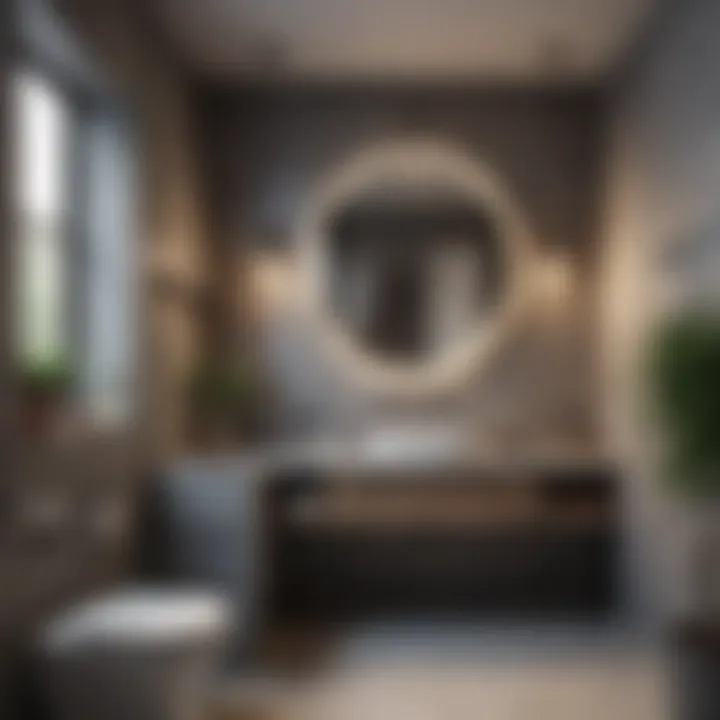
When selecting these items, consider both form and function. Look for decor that complements the existing color scheme and style to create a cohesive look without over-cluttering the space.
Artwork and Accessories
Choosing the right artwork and accessories can significantly elevate the aesthetic of a small bathroom. These elements should be chosen carefully to avoid overwhelming the space but should still provide visual interest. When selecting artwork and accessories:
- Limit Size: Opt for smaller art pieces that can add character without dominating the wall space. Framed prints or small canvases can work well.
- Go for Textures: Accessories that add texture, such as woven baskets or fabric-based decor, can create depth and warmth in the bathroom.
- Color Coordination: Ensure that the chosen artwork echoes the light colors and accent shades already established in the bathroom. This can help to maintain a harmonious flow throughout the space.
- Nature Themes: Nature-inspired artwork, such as abstract images of leaves or calming water scenes, can instill tranquility.
Incorporating these elements does not require a significant budget, as one can find elegant yet affordable options that contribute to the overall theme. Remember that the goal is to create a personalized feeling while ensuring that decor does not hinder functionality.
A carefully curated selection of decor can transform a small bathroom into a space that feels as expansive as it is stylish.
Eco-Friendly Options for Small Bathrooms
In today’s world, where sustainability is becoming increasingly important, incorporating eco-friendly options into small bathroom designs is essential. This approach not only enhances the aesthetic appeal but also contributes to a healthier planet. The use of sustainable materials and water-saving fixtures can significantly reduce environmental impact while providing the homeowner with functional and stylish options. Small bathrooms are not exempt from this trend; even limited spaces can benefit from thoughtful choices that prioritize environmental responsibility.
Sustainable Materials
When selecting materials for small bathrooms, choosing sustainable alternatives can have a positive effect. Materials such as bamboo, reclaimed wood, and recycled tiles are wonderful options. Bamboo, for instance, is known for its rapid growth and minimal environmental footprint. It provides a natural look that enhances the overall aesthetic of the space.
Reclaimed wood adds character and warmth, showcasing a story within its design. Additionally, selecting tiles made from recycled materials can not only cut down waste but also provide a unique design element. By opting for these sustainable materials, homeowners create spaces that reflect their values while ensuring durability and resilience against moisture and wear.
"Sustainable materials not only contribute to the environment but also elevate the visual appeal of a small bathroom."
Water-Saving Fixtures
Water conservation is critical in any bathroom, and installing water-saving fixtures is a straightforward way to achieve this. Low-flow toilets and faucets are pivotal in reducing water usage without sacrificing functionality. Low-flow toilets can use as little as 1.28 gallons per flush compared to older models that may consume more than 3.5 gallons. This simple change can drastically lower water bills over time.
Faucets equipped with aerators can reduce water flow while maintaining pressure, making them an excellent choice for small bathrooms.
Furthermore, delivering more aesthetic choices, modern showerheads designed for water efficiency add to a bathroom's visual appeal. These fixtures allow homeowners to save water effortlessly while enjoying a luxurious bathing experience. Incorporating water-saving fixtures, therefore, aligns well with the goal of maximizing space and style in small bathrooms while caring for the environment.
Creating small bathrooms with eco-friendly options is essential for both individual well-being and the health of our planet. By thoughtfully connecting sustainable materials and water-saving fixtures, homeowners can make informed choices, transforming their limited spaces into stylish yet responsible environments.
DIY Projects for Small Bathroom Enhancements
DIY projects offer a unique opportunity for homeowners to personalize their small bathrooms. Engaging in these projects allows for creative freedom while potentially saving money, making them an attractive option for those looking to transform their spaces. Each DIY initiative, no matter how small, can significantly elevate the functionality and appearance of a compact bathroom. Moreover, the sense of accomplishment from completing a project can further enhance the overall satisfaction of creating a space that reflects personal style.
Easy Updates
Making easy updates in a small bathroom does not require extensive skills or large amounts of time. Simple swaps can greatly refresh the space without overwhelming it.
- Change Fixtures: Switching out bathroom faucets or cabinet handles can provide an instant update. Consider contemporary designs that align with the desired aesthetic.
- Paint: A fresh coat of paint can redefine the space. Light colors promote the illusion of a larger area, while well-chosen accent colors can add depth.
- Accessorize: Incorporating new towels or rugs can bring color and texture. Opt for textiles that are durable and easy to clean, particularly in a bathroom environment.
Small changes can significantly alter the perception of space, making it feel more inviting and stylish.
Budget-Friendly Renovations
For those willing to invest a bit more time or effort, budget-friendly renovations can create a noticeable transformation without breaking the bank.
- Refinish Cabinets: Instead of replacing bathroom cabinets, consider refinishing them. Sanding and repainting existing cabinetry can breathe new life into old furniture.
- Peel and Stick Tile: For flooring or backsplashes, peel and stick tile offers an affordable solution. It is easy to apply and can mimic high-end materials without the high price tag.
- Mirror Upgrades: Replacing an existing mirror or adding a decorative frame can enhance both aesthetic appeal and functionality in a small bathroom. A larger mirror can also create the illusion of more space.
These budget-friendly upgrades allow homeowners to achieve a transformative look while remaining mindful of costs.
"The beauty of DIY lies not only in cost-saving but also in creating a space that is entirely yours."
Epilogue: Achieving Balance in Small Bathroom Design
A well-designed small bathroom can be a sanctuary that maximizes both functionality and aesthetic appeal. Achieving balance in this unique space requires a thoughtful approach. Designers and homeowners alike must recognize the constraints of a small area while still making it visually appealing and practical.
Importance of Balance
Creating a harmonious environment in a small bathroom fundamentally involves the careful selection of colors, fixtures, and accessories. When each element complements the others, the space becomes inviting. Balance also means ensuring that the bathroom functions efficiently without overcrowding it.
Key Considerations
When finalizing designs, consider the following elements to maintain balance:
- Proportions: Select fixtures that fit the scale of the space. For example, opting for a compact sink allows more room for movement.
- Color Coordination: Light colors can open up the space, while well-placed accent colors provide a pop without being overwhelming.
- Textiles and Accessories: Choose decor that offers functionality, such as baskets for storage that also enhance visual appeal.
"A small bathroom can serve as a practical space while also being aesthetically pleasing. Balance is key."
Benefits of Achieving Balance
Striking the right balance in a small bathroom leads to multiple advantages:
- Increased Comfort: A balanced design creates a calming atmosphere, making the bathroom a more enjoyable space.
- Improved Accessibility: Well-organized areas allow easy movement, ensuring that the space is user-friendly.
- Enhanced Value: A well-executed design can increase property value, appealing to potential buyers.



